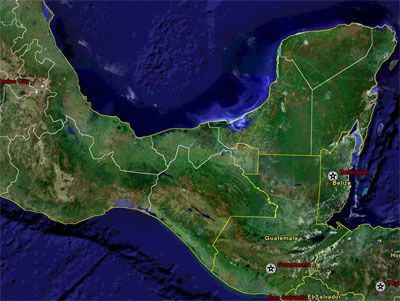MEXICO
Please note, this page is not longer being updated. For more recent information, please see news.mongabay.com and use the search function to find the country feed. For more up-to-date data on forest cover and loss, check out Global Forest Watch.
| Mexico Forest Figures
Forest Cover Total forest area: 64,238,000 ha % of land area: 33.7% Primary forest cover: 32,850,000 ha % of land area: 17.2% % total forest area: 51.1% Deforestation Rates, 2000-2005 Annual change in forest cover: -260,400 ha Annual deforestation rate: -0.4% Change in defor. rate since '90s: -21.1% Total forest loss since 1990: -4,778,000 ha Total forest loss since 1990:-6.9% Primary or "Old-growth" forests Annual loss of primary forests: -395000 ha Annual deforestation rate: -1.1% Change in deforestation rate since '90s: 11.3% Primary forest loss since 1990: -1,975,000 ha Primary forest loss since 1990:-15.3% Forest Classification Public: 58.8% Private: n/a Other: 41.2% Use Production: 0.1% Protection: 1.5% Conservation: 6.8% Social services: n/a Multiple purpose: 91.5% None or unknown: n/a Forest Area Breakdown Total area: 64,238,000 ha Primary: 32,850,000 ha Modified natural: 30,330,000 ha Semi-natural: n/a Production plantation: 72,000 ha Production plantation: 986,000 ha Plantations Plantations, 2005: 1,058,000 ha % of total forest cover: 1.6% Annual change rate (00-05): n/a Carbon storage Above-ground biomass: n/a M t Below-ground biomass: n/a M t Area annually affected by Fire: 194,000 ha Insects: 8,000 ha Diseases: 2,000 ha Number of tree species in IUCN red list Number of native tree species: 1,130 Critically endangered: 0 Endangered: 7 Vulnerable: 23 Wood removal 2005 Industrial roundwood: 7,667,000 m3 o.b. Wood fuel: 684,000 m3 o.b. Value of forest products, 2005 Industrial roundwood: $545,479,000 Wood fuel: $19,216,000 Non-wood forest products (NWFPs): $32,134,000 Total Value: $596,829,000 More forest statistics for Mexico |
Conflict in Chiapas has contributed to forest loss by displacing poor subsistence farmers, while military exercises by the army and rebel forces have degraded forest areas. Oil deposits in the Lacandon forest of Chiapas may soon be targeted in an era of high energy prices.
Illegal logging and poaching are widespread in Mexico. Criminal syndicates dominate the illicit timber trade, and parks are common targets for wood extraction.
Despite these threats, Mexico's forests have a great deal of potential for eco-tourism. While tourism, already one of Mexico's most important sources of income, has traditionally had negative impacts on the country's environment through land-clearing and pollution, ecologically sensitive tourism could provide economic justification for preserving wildlands. Mexico is one of world's five most biodiverse countries, home to at least 26,071 species of vascular plants, of which 48 percent are endemic, and to 2,765 known species of amphibians, birds, mammals, and reptiles, 34 percent of which are endemic. Further, Mexico has a number of cultural and archeological attractions for visitors.
Environmentalism in Mexico is increasing, and the government has lately taken a number of steps to reduce pollution and illegal use of forest lands, including encouraging the expansion of plantations to supplant natural forest use. Although 5,925,000 hectares of primary forest disappeared between 1990 and 2005, deforestation rates of primary forest have decreased 15.3 percent since the close of the 1990s. Mexico announced its first-ever national environmental plan in 1996.
Recent articles | Mexico news updates | XML
Suggested reading - Books
- Lonely Planet Mexico
- A Field Guide to the Mammals of Central America and Southeast Mexico
- The People's Guide to Mexico
- Endangered Mexico: An Environment on the Edge
- Homage to Chiapas: The New Indigenous Struggles in Mexico
- Frommer's Mexico 2006
- A Guide to the Birds of Mexico and Northern Central America
- Mexico (Eyewitness Travel Guides)
Unless otherwise specified, this article was written by Rhett A. Butler [Bibliographic citation for this page]
Other resources
Contact me if you have suggestions on other rainforest-related environmental sites and resources for this country.

Image copyright Google Earth, MDA EarthSet, DigitalGlobe 2005
CIA-World Factbook Profile
FAO-Forestry Profile
Last updated: 5 Feb 2006
